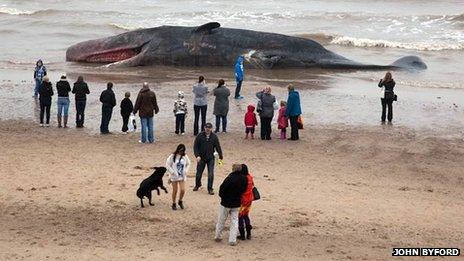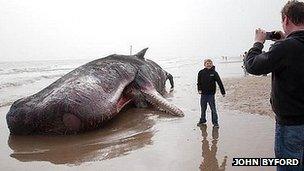What happens after a whale is beached?
- Published

Hundreds of people visited Skegness to see the male sperm whale
A whale which beached in Skegness on Saturday was the fourth to wash up at the Lincolnshire resort in recent years. So how common is it for whales to wash ashore - and what happens to their carcasses?
When the sperm whale washed up in Skegness on Saturday it became something of a tourist attraction.
Hundreds of people visited the beach to see the creature and some had photographs taken standing next to it.
But the sight was not as unusual as one might expect.
Whale for sale
The Cetacean Strandings Investigation Programme (CSIP), which investigates whale, dolphin and porpoise strandings on behalf of Defra, recorded nine cases of sperm whales being washed ashore in the UK last year.

Some had their photos taken by the whale before it was covered in sand because of the strong smell
Earlier this year police investigated claims parts of a dead whale found in Norfolk were offered for sale on Facebook.
Rob Deaville, project manager for CSIP, said the whale parts would technically belong to the Crown.
"They are classified as royal fish," said Mr Deaville, who works for the Zoological Society of London.
"A very ancient statute gave the head of the Crown the right to all the cetaceans stranded around the UK.
"The king had the right to the head and the queen had the right to the tail."
But Mr Deaville is not aware of a monarch ever asking for part of a whale.
"The royal prerogative has transferred to the Receiver of Wreck, within the Maritime and Coastguard Agency, but in practice our project gets first dibs," he said.
After being made aware of a stranded whale CSIP decides whether to examine it or not.
Whale specimens are also gathered by the Natural History Museum, which was given access to the carcasses of dead, stranded cetaceans for the purposes of scientific investigation under an agreement negotiated in 1913.
"They are so hard to study in the wild that strandings give you a unique opportunity to learn more about them," said Mr Deaville.
Since being contracted by Defra in 1990, CSIP has recorded about 10,500 strandings of dead and living cetaceans and approximately 10% each year are whales.
Of these 10,500 strandings, CSIP has carried out post-mortem examinations on about 3,000.
These tests are sometimes carried out before a whale has been moved, depending on how big and difficult it is to transport.
Too decomposed
People speculated that the recent Skegness whale could have been killed by a boat because it had a large gash.
However, it was not examined because it was thought to be too decomposed.
"It may well be consistent with a boat strike but we can't say for sure without having examined it and we can't say it wasn't done post mortem," said Mr Deaville, after viewing photographs.
If whale deaths are related to human activities then the information gathered can be used to prevent further deaths.
But Mr Deaville said a lot of whales starve.
"We only get male sperm whale strandings in the UK and the ones we've examined post mortem have all shown evidence of a lack of recent feeding," he said.
Sperm whales usually become stranded in Scotland or along the east coast of England.
"It seems they get into the North Sea where they can't feed," said Mr Deaville.
"The females are probably part of a matriarchal unit elsewhere."
'Riding' a whale
One of the most high-profile whale deaths in the UK in recent years was that of a northern bottle-nosed whale which swam up the Thames in January 2006 and died after lengthy attempts to rescue it.
A year later the whale's skeleton went on display at a newspaper office, on loan from the Natural History Museum.
Just as crowds gathered to see the Skegness whale, tens of thousands of people lined the Thames to watch the London whale swim past. And the animals, dead or alive, tend to be an interesting and rare enough sight to attract attention.
In September 2009 people took turns to climb on and "ride" the body of a minke whale which washed ashore in Barry, in the Vale of Glamorgan.

The whale was moved in the early hours of Wednesday so the tide could wash Skegness beach
But a decomposing whale can be a public health risk, meaning councils or private landowners usually have a responsibility to dispose of the bodies.
"I am aware of incidents where it has been left in situ so it can decompose naturally, where you can't physically move it anyway and the risk to public health is fairly low," said Mr Deaville.
"In parts of Scotland some whales have been buried."
The council or landowner must cover the cost of the disposal.
East Lindsey District Council estimates the recent Skegness whale will cost about £10,000 to dispose of but the cost varies depending on the size and weight.
Exploding whales
Depending on the circumstances a number of licences need to be granted before a whale can be moved and disposed of, including from the Marine Management Organisation (MMO).
Many are taken to landfill sites, such as the Skegness whale which was taken to Winterton, in North Lincolnshire. Others are disposed through incineration or rendering.
There is film footage from 1970 of a whale in Florence, Oregon, in the United States, being disposed of by explosion.
"We don't do that in the UK and we don't advise that either, because you would be left with bits of whale over the beach which you've still got to clean up," said Mr Deaville.
However, dead whales can explode naturally, such as when a sperm whale was being transported to a research centre in Tainan, Taiwan, in 2004.
"That actually exploded en route because of the gases building up inside," said Mr Deaville.
"How long it would take [for a whale to explode] we just don't know. It would depend on a lot of factors."
- Published4 March 2012
- Published4 January 2012
- Published31 December 2011
- Published30 September 2011